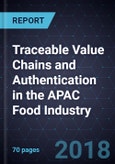Food Safety, Traceability and Authenticity are at the Forefront of Consumer Minds; New Technologies are Breaking through Traditional Quality Systems to Address these Unmet Needs
Traceable value chains provide a chain of custody for a product or ingredient through a supply chain. Recent developments in traceability technology and forensic laboratory authentication methods have allowed new market segments to emerge within the food industry. This report explores how different elements integrate into a comprehensive traceability system. These elements include data capture devices, data carriers, traceability databases and interfaces, laboratory authentication services and certification services.
Traceability infrastructure and authentication technology both serve to protect food integrity. Traceable value chains are segmented into four applications and their respective markets.
Within the market for Critical Tracking Event (CTE) technology, RFID and scanning devices are well-established methods for capturing transaction and process data. Producers and food manufacturers are shifting towards more interoperable and simple systems that are flexible enough to avoid data redundancies due to regulatory incompatibility. This has placed a large focus on Key Data Event (KDE) information systems that provide the software to manage complex food supply chains. Large customers are developing their own platforms, exerting pressure on their suppliers to commit to integrating internal systems or risk losing supply contracts. As food scandals persist, consumers are expecting label certifications and added assurances through QR code scanning and tamper-proof packaging. Consumer mistrust results in an increased focus on product brand and place of origin. Authentication services and certifications enable new market segments that have evolved from the traditional food safety testing industry.
Only the non-targeted or profiling applications of food authentication are explored in this study. Although this is a minor and novel part of the current market, forensic authentication indicates the direction of traceable value chain practices and the value to food companies. For example, a major shift in consumer perceptions around authenticity has developed since the 2008 Sanlu melamine milk powder scandal. Market leaders in APAC recognise the need to mitigate the reputational damage when groups of companies are implicated in a scandal. Third-party testing agencies and certification bodies are beginning to provide authenticity capabilities but there remains significant uncertainty around which models will become industry standards.
Interviews were conducted with stakeholders in various food supply networks in Asia, Pacific and China. In addition, the shifts in market access requirements and market competition are addressed, including an analysis of market risks and opportunities. The results yielded insights into the direction of the market and current limitations for food manufacturers and distributors.








